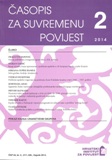Prostorni vidici industrijalizacije u Istri od 1918. do 1940.: primjeri razvoja rudarske industrije i industrije građevnih materijala
SPATIAL PERSPECTIVE OF INDUSTRIALIZATION IN ISTRIA DURING THE PERIOD FROM 1918 TO 1940: EXAMPLES OF DEVELOPMENT IN MINING AND BUILDING MATERIALS INDUS
Author(s): Hrvoje RatkajecSubject(s): History
Published by: Hrvatski institut za povijest
Keywords: Istria; Industrialization; Fascist economic policy; Bauxite; Coalmines; Cement plants
Summary/Abstract: The purpose of this article is to introduce the spatial characteristics of the industrialization process in Istria during the period from 1918 to 1940. It was the period when the area of the European periphery was also enveloped by the process of industrialization, and at the same time there were significant political and economic changes due to the fact that Istria became a part of the Kingdom of Italy after the World War I and the fall of the Austro-Hungarian Empire, which resulted in the establishment of the new (fascist) economic relations and politics. The article is directed towards the analysis of the three industries – bauxite-mining, coal-mining and cement production – which were some of the major industries in the region of Istria. The research area is limited to the Croatian part of the Istrian peninsula. General theory of location was used as a methodology, or to be more precise, locational factors which can explain why the industrial plants were built only on specific locations. Then follows the theory of half-growth which explicates that industrial activities are connected in the area through some central point, i.e. a city which is typically the largest industrial centre in the area (of localization and urbanization economies) and MAR and Jacobs economy that allows us to understand the development of industrial activities outside the city influence. The basis for the research was the economic and socio-historiographical analysis of work and activities of particular industrial enterprises in the selected fields. The analysis could determine the presence and operation of location factors, localization, urbanization, MAR and Jacobs economies through which it is possible to observe the presence and effects of various economic policies. First archival sources were registers of enterprises from the National Archives in Trieste, supplemented with the archival sources from the National Archives in Pazin. The results of the analysis show that the mining industry and cement production were quite dispersed over Istria regarding the fact that the development of plants was directly associated with the mining sites. Also we cannot claim that the companies were interconnected in the way of localization economies. Furthermore, we can observe how those industries were exploiting the existing Istrian transport infrastructure. The analysis confirms previous findings that the transport, i.e. road infrastructure in the interior of Istria was (very) weak and that the enterprises rather used the docks for an efficient transport of raw materials. All three industries were, by the number of employees, among the key ones in the Istrian province. The forefront was the mining industry in Labin. Trieste appeared as a centre of venture capital and knowledge and as a source of investment, which means that urban environment affects the development of industry in a non-urban environment, the environs outside the city.
Journal: Časopis za suvremenu povijest
- Issue Year: 46/2014
- Issue No: 2
- Page Range: 319-339
- Page Count: 21
- Language: Croatian

